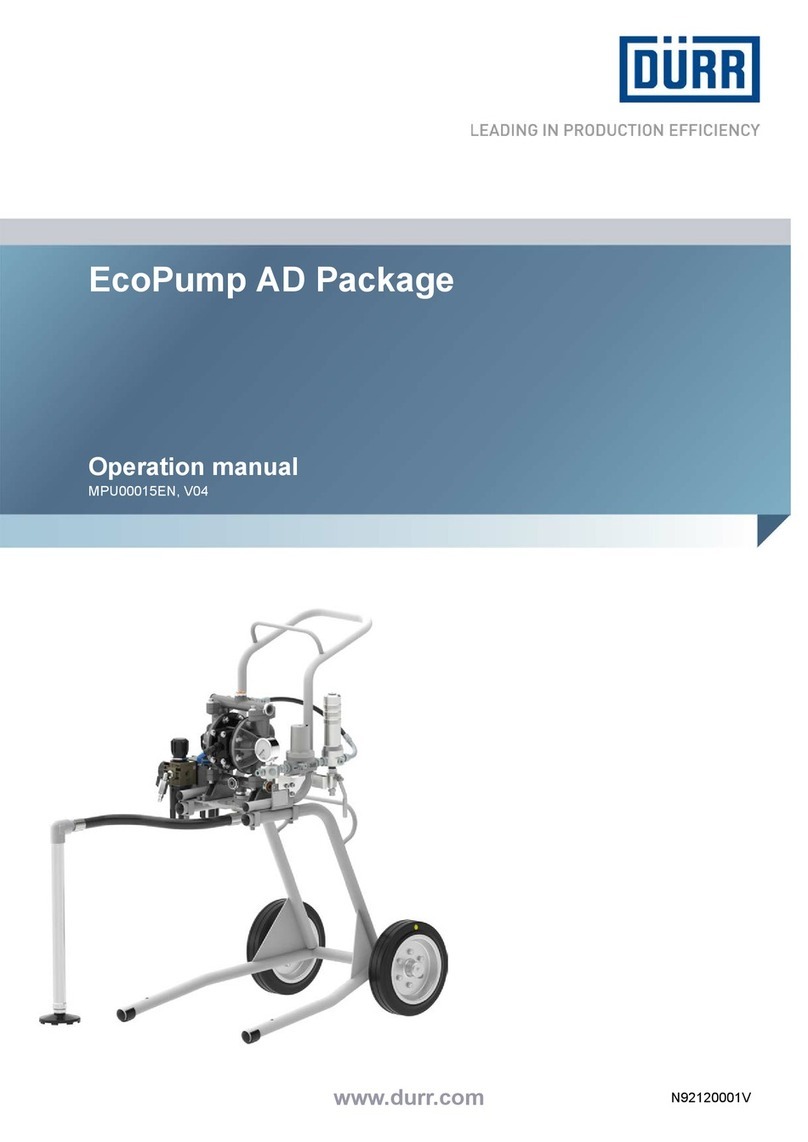
TABLE OF CONTENTS
1 Product overview...................................... 6
1.1 Overview............................................. 6
1.2 Short description................................. 6
2 Safety.......................................................... 6
2.1 Presentation of Notes.......................... 6
2.2 Intended Use....................................... 6
2.3 Residual risks...................................... 7
2.4 Conduct in the event of a hazardous
situation............................................... 7
2.5 Staff qualification................................. 8
2.6 Personal protective equipment............ 8
3 Design and Function................................. 9
3.1 Control Unit......................................... 9
3.2 Motor................................................... 9
3.3 Fluid part............................................. 9
4 Transport, scope of supply and
storage..................................................... 10
4.1 Unpacking......................................... 10
4.2 Transport........................................... 10
4.3 Scope of delivery............................... 10
4.4 Handling of packaging material......... 11
4.5 Storage.............................................. 11
5 Assembly.................................................. 11
5.1 Safety recommendations................... 11
5.2 Requirements for the
Installation point................................. 11
5.3 Assembly........................................... 11
5.4 Connecting........................................ 13
6 Commissioning....................................... 14
6.1 Safety recommendations................... 14
6.2 Commissioning.................................. 15
6.3 Setting operating parameters ........... 15
7 Operation................................................. 15
7.1 Safety recommendations................... 15
7.2 General notes.................................... 16
7.3 Rinsing.............................................. 16
7.3.1 Safety recommendations................ 16
7.3.2 Flush the pump............................... 16
8 Cleaning................................................... 16
8.1 Safety recommendations .................. 16
8.2 Cleaning............................................ 18
9 Maintenance............................................. 18
9.1 Safety notes...................................... 18
9.2 Maintenance schedule...................... 19
9.3 Dismantle and assemble................... 20
9.3.1 Disassemble control unit................ 20
9.3.2 Dismantle control unit..................... 20
9.3.3 Assemble control unit..................... 21
9.3.4 Assemble control unit..................... 22
9.3.5 Disassemble fluid part and con-
necting rods.................................... 23
9.3.6 Dismantle motor............................. 24
9.3.7 Assemble motor.............................. 26
9.3.8 Dismantle fluid part......................... 26
9.3.9 Assemble fluid part......................... 29
9.3.10 Assemble fluid part and connecting
rods................................................ 29
10 Faults........................................................ 30
10.1 Defects table................................... 30
10.2 Troubleshooting............................... 32
10.2.1 Replace switchover valve............. 32
10.2.2 Bring diaphragm in the control
unit in the home position.............. 33
10.2.3 Assembling ice reduction............. 33
11 Disassembly and Disposal..................... 35
11.1 Safety recommendations................. 35
11.2 Disassembly.................................... 36
11.3 Disposal .......................................... 37
12 Technical data.......................................... 37
12.1 Dimensions and weight................... 37
12.2 Connections.................................... 38
12.3 Operating conditions....................... 38
12.4 Emissions........................................ 38
12.5 Operating values............................. 38
12.6 Compressed air............................... 39
12.7 Type plate........................................ 39
12.8 Materials used................................. 40
12.9 Operating and auxiliary materials.... 40
12.10 Characteristic curve of the outflow
rate.................................................. 41
12.11 Material specification....................... 41
13 Replacement parts, tools and accesso-
ries............................................................ 42
13.1 Replacement parts.......................... 42
13.1.1 Control Unit.................................. 42
13.1.2 Fluid part...................................... 43
13.1.3 Motor............................................ 45
13.1.4 Repair kits.................................... 46
13.1.5 Seal sets....................................... 47
13.2 Tools................................................ 48
13.3 Accessories..................................... 48
02/2020EcoPump VP - MPU00003EN4/52
































